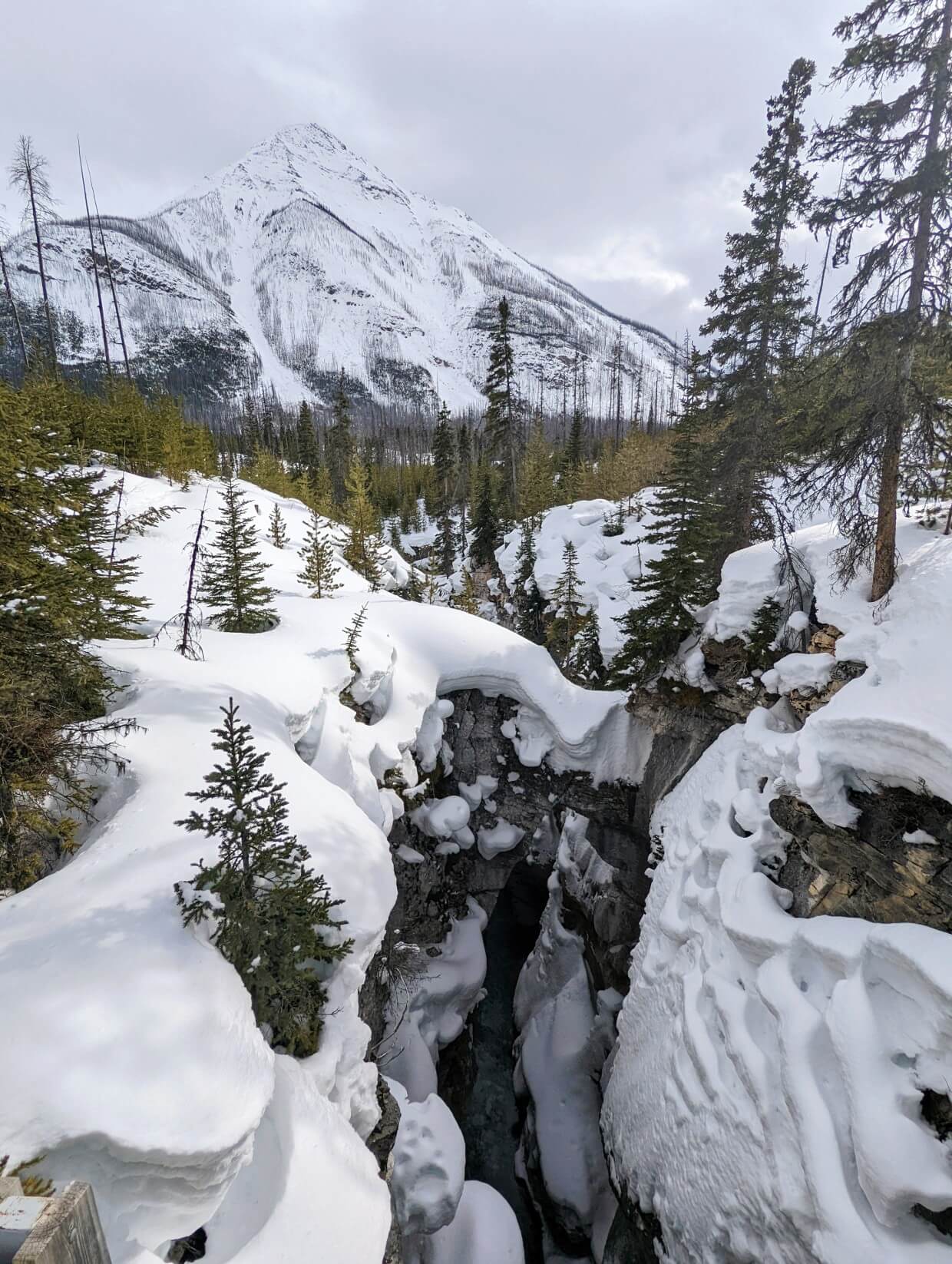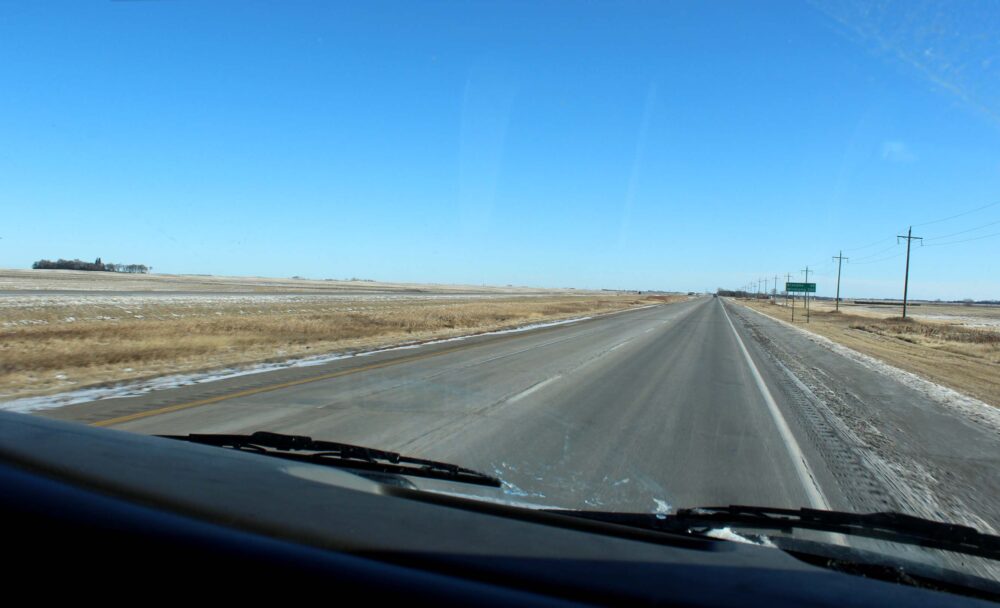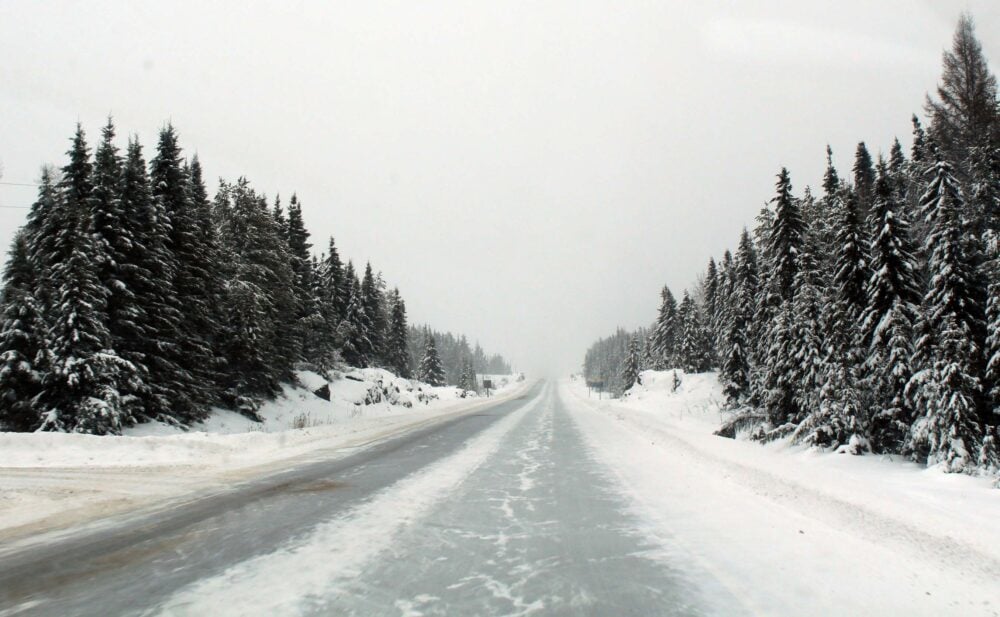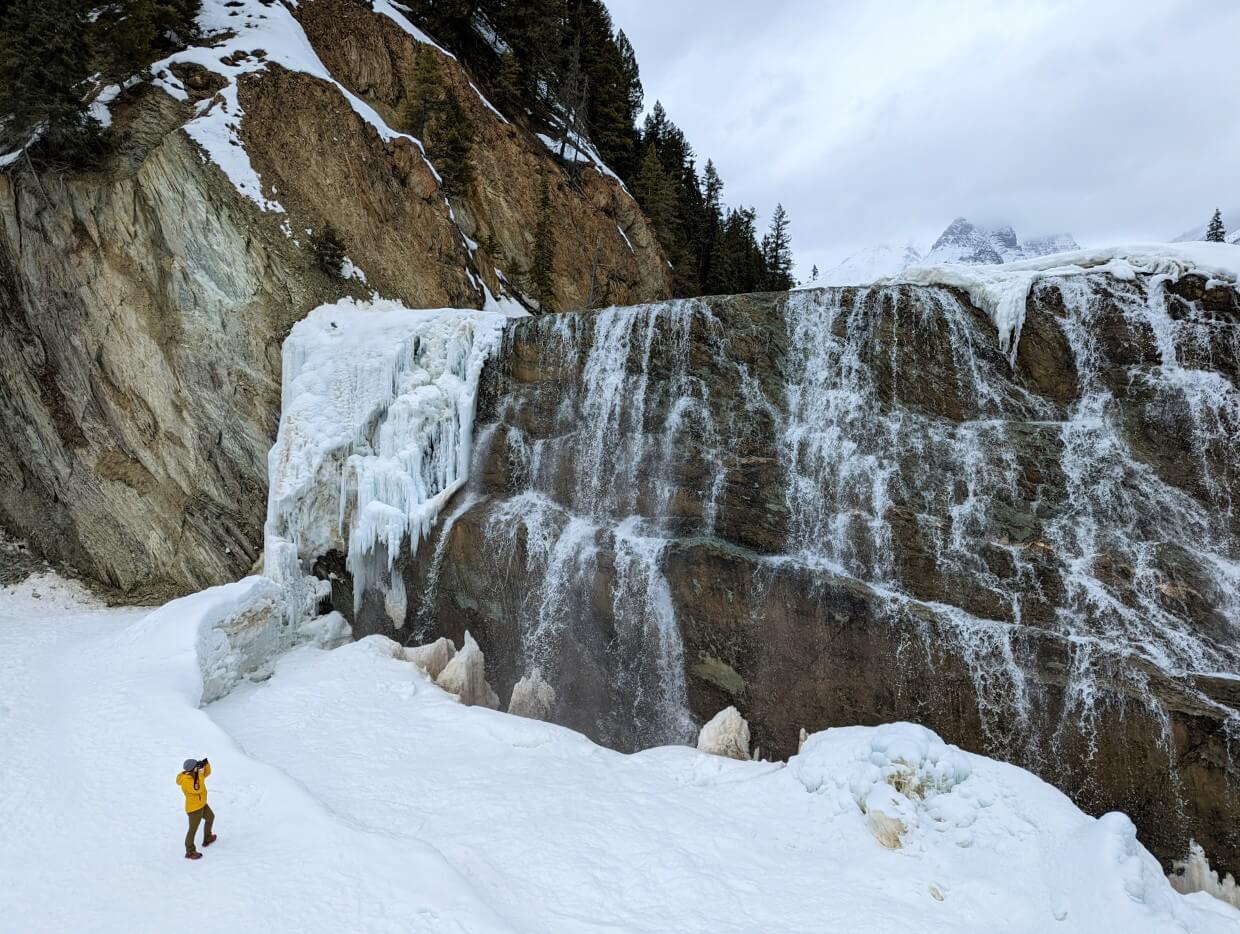Experience the beauty of the coldest season with a winter road trip in Canada. Enjoy uncrowded destinations, cheaper prices and wonderfully snowy scenery.
Of course, winter road trips in Canada present more challenges than their summer counterparts.
Navigating icy roads and preparing for colder temperatures require additional planning to ensure a safe and enjoyable journey.
After living in Canada for 10+ years, we’ve embarked on many winter road trips together.

The longest and most difficult was a 4700km two-week December road trip across Canada. We experienced sun, snow, ice, blizzards, high winds, slush and freezing temperatures.
For work, we once had to drive from Fort St John in BC’s ‘near sub-arctic’ to Rocky Mountain House in Alberta, a 1500km return trip.
It was -40c for the entire three day journey and we ended up in the ditch next to the road after drifting snow blocked the view. It was a little scary!
Another of our most challenging winter roads trips was as a 2000km mid March adventure from the Okanagan Valley in BC to Pigeon Lake, Alberta, via Banff, Radium Hot Springs and the Icefields Parkway. The photo below demonstrates some of the winter driving conditions we encountered.
This post shares everything I would want visitors to know before setting out on a winter road trip in Canada, including winter driving hazards, winter road trip planning tips and must have items.
There are affiliate links in this post. If you make a qualifying purchase through one of these links, I may receive a small commission at no extra cost to you.

Be prepared for short driving days
Daylight is limited during the winter months, especially in Canada. I don’t know about you, but I hate driving in the dark, especially during winter when blizzards, black ice and freezing rain is all possible.
When we drove across Canada in winter, we drove when the sun was coming up and generally stopped soon after it went down. This reduced our driving window to approximately 7am – 4pm, depending on time zone and location.
If you have a similarly long trip to make in winter, don’t forget that you’ll probably pass through a few different time zones. Remember that the time of sunrise and sunset will vary as you drive across different provinces and territories.
Start early and get off the road as early as possible, especially if weather conditions are unfavourable.

Pick your destinations carefully
You’ve probably already guessed, but due to adverse weather conditions and lack of visitors, many attractions in Canada have either reduced hours or are completely closed in winter.
A lot of provincial and territorial parks will have limited access or will be completely closed to visitors.
Don’t worry, however, there are still places to visit and things to see but you need to plan ahead and be a little more inventive. Hot springs, in particular, are a great place to stop when road tripping Canada during winter.

Be aware of limited roadside facilities
In a similar theme to the above advice, many roadside facilities are shut during winter. This includes things like toilets, visitor centres and rest stops.
Typically, large rest stop buildings are completely locked (we found Ontario the worst for this) in winter. Quite often, the road leading to these facilities isn’t snowploughed at all.
It is also important to know that some gas stations are closed during winter. On our cross Canada road trip, this was only a problem on Highway 1 between Kenora and Sault St. Marie. I definitely wouldn’t advise risking a low gas tank in this area.
It’s a good idea, in general, to keep your vehicle topped up with gas to prevent the fuel-line freezing up during winter road trips.

Don’t rush on your winter road trip in Canada
I know it almost goes without saying, but on a winter road trip in Canada, you MUST be prepared to drive slower than normal.
Slippery roads, reduced visibility, heavy snowfall and black ice may not just slow progress down, but force you to pause or stop the trip completely.
In extreme conditions, highways are sometimes closed. For this reason, plan plenty of extra time to get to your destination(s).
To put this into perspective, consider that some people drive across Canada in summer within just four (very long) days. In winter, this would be an unrealistic, and potentially dangerous, challenge.

Unexpected winter road trip hazards
When heading out to drive across Canada in winter, I anticipated tough road conditions and weather. Some things, however, I did not think about were:
- Road signs can become completely covered in snow, making navigation sometimes difficult. This shows exactly why it is useful to have both a physical map (I personally love Backroad Mapbooks) and offline access to Google Maps.
- Despite being Canada’s major road across the country, Highway 1 doesn’t necessarily have phone signal all the way along it. There is intermittent service through the Rockies and also from Wawa to the outskirts of Sault St. Marie.
- High winds can cause snow drifts in unexpected places. Be careful because snow drifts can be surprisingly deep and make for difficult driving.
- Most of Highway 1 across Canada is double lane separated highway. There are, however, large sections in Northern Ontario and smaller stretches in British Columbia that are just one lane only. In these areas, it is easy to be momentarily blinded by snow flurries caused by oncoming vehicles (especially trucks).
- Wildlife! Not all of Canada’s local animal population goes to sleep in winter. We’ve seen moose, bighorn sheep, lynx (!) and deer in winter. These animals are usually most active at dusk and dawn, which can be a huge hazard with the reduced visibility at that time.

Must have items for any winter road trip in Canada
There are some essential items required for winter road trips in Canada.
I’ve also added a couple of extras that we found very helpful during our long trip across Canada.
Winter tires
Winter tires are made with a special type of rubber that provides increased traction and control in cold, snowy and icy conditions. Look for tires bearing the mountain snowflake symbol.
Somewhat surprisingly, the use of winter tires is only mandatory in a few provinces. In British Columbia, for example, winter tires or chains are required on most highways from 1st October to 30th April (31st March on some roads). Over in Ontario, using winter tires is recommended but not required.
Personally, I’d recommend using winter tires almost everywhere in Canada (some exceptions on BC’s coast). If you don’t have much winter driving experience, I’d say winter tires are absolutely essential!
When hiring a vehicle for a winter road trip, be sure to request winter tires. My favourite BC vehicle rental company, FarOut Wilderness, provides 4X4 trucks with winter tires. Enjoy a 5% booking discount if you tell them I sent you (with the code FOW-OTT-5).
Shovel and tow rope
While you hope not to use them, a shovel and tow rope are essentials for winter road trips in Canada.
Our shovel has come in handy a few times over the years. We’ve had to dig ourselves out of a few unploughed parking lots, for example.
For our trip across Canada, we purchased an avalanche shovel. Usually carried while backcountry skiing, avalanche shovels are lightweight and pack down small. We still use it today and it fits nicely into our Toyota Echo.
If you have the space, obviously a bigger shovel would be preferable for long winter road trips.

Jumper cables
Winter weather isn’t kind to car batteries, to say the least. Be sure to carry some jumper cables, just in case.
Luckily, we’ve never had to use jumpers on our vehicle but we have helped half a dozen other people over the years. On one memorial occasion, we helped someone start their vehicle just a few blocks from Niagara Falls in -20c!
Lots of windscreen washer fluid
On our big cross Canada road trip, we used over 20 litres of windscreen (or windshield) washer fluid. Yes, really! And that was in relatively good winter weather.
With so much snow, ice, dirt and general grime splashing up on the windscreen, washer fluid is absolutely essential during winter road trips to keep clear visibility. There were times when we had to use it after every passing vehicle.
Make sure you buy winter windscreen washer fluid rated to -40c or lower. Consider also replacing your windscreen wipers if they are not winter-rated.
Emergency kit
No matter how long your road trip is, bring an emergency kit. It should include:
- Blanket(s)
- Food
- Gloves and warm hat
- Wind-up flashlight or headlamp
- First aid kit
- Extra clothing
- Water (see below)
This equipment could save your life if road conditions force you to be stuck in your vehicle.
Clothing-wise, be sure to have lots of different layers. When driving, the vehicle will be warm and hence less clothing will be needed.
But if your vehicle gets stuck in adverse weather, more layers will quickly be required as well as warm, waterproof winter gloves and boots.

Insulated flasks
Cold weather freezes liquids. Ergo, water is harder to store on a winter road trip. The solution, however, is easy. Insulated flasks.
Used most often for coffee and tea, you can also use insulated flasks to keep water and other liquids cold (but not frozen) in freezing conditions.
One morning, we had absolutely nothing unfrozen to drink except what was in our Hydroflask. Be sure to have at least one insulated flask in your vehicle.
Cooler
Following on from the last suggestion, a cooler can be useful on a winter road trip in Canada. If possible, store any kind of fresh food in one of these to give it a little more protection against the cold temperatures.
Of course, always carry some dried food (granola bars, nuts) that will still be edible even if they happen to freeze and defrost a few times.

And remember…
To still have fun! Winter road trips in Canada are more challenging, however, it can be an enjoyable experience.
Everything looks somehow even more beautiful under cover of snow. Canada is truly a winter wonderland in every sense.
Be sure to read this winter driving advice, prepare your vehicle properly before heading out on the road and clean your vehicle fully of snow before driving!

Other winter posts you may find helpful
The Complete Guide to Travelling Canada in Winter
65 Cool Things to Do Across Canada in Winter
8 Must See Places On A Winter Road Trip Across Canada
What to Wear in Canada in Winter: A Complete Guide
Snowshoeing 101: A Beginner’s Guide
Check out these recently published posts:

One half of the Canadian/British couple behind Off Track Travel, Gemma is happiest when hiking on the trail or planning the next big travel adventure. JR and Gemma are currently based in the beautiful Okanagan Valley, British Columbia, Canada. Consider buying us a coffee if you have find any of our guides helpful!




Sounds like you just drove across Canada in the winter 😉 Great post! Your advice was clear and accurate. It is amazing how hard it is to find the right advice when looking for weather conditions to the place you want to travel. Glad you guys had a good time! Peace, Happy New Year.
Haha, indeed! I’m glad you found the info helpful 🙂
Hi, thank you very much for your article! i’m planning to rent a car during winter in Canada for my road-trip. Du you think a small car is okay or should I go fora SUV?
Thank you!
Hi Nicolas! It’s difficult to say without knowing your trip plans but personally, I feel more comfortable driving during winter in Canada with an AWD vehicle. Of course, there are plenty of smaller cars on the roads here but they are most common in cities.
Hi!
I’m planning a winter roadtrip through Canada in January. I was just wondering how many kilometres can you drive during the day on the winter roads? (My and my friend have no experience in winter driving).
Thanks!
Hi Eliza,
It really depends on the conditions, weather and location so I’m afraid there isn’t a single answer for your question. When we drove across the Prairies in December, it was -30c but it was sunny and the roads were clear. We were able to drive almost regular speed. When driving through Ontario, however, there was a snow storm and we had to drive slower and then finally stop due to the terrible road conditions.
Hi Gemma, I’m just curious what locations you stayed at during the trip across Ontario. Like you said sometimes weather in the winter causes you to stop earlier than planned. I have done it 3 times during summer and spring so I was able to go from NB to Petawawa to Sault to Thunder Bay then Winnipeg etc..
I’m wondering if you made any additional stops throughout Ontario and where. I’m trying to plan our winter route knowing that those stops are likely going to be too far in a day.
Thanks in advance!
Hi Jenna!
We drove Winnipeg to Kenora (to see a friend) and then that’s when we were hit by storms. From Kenora we had hoped to get past Thunder Bay but stopped around the city instead. We were then aiming for Sault St Marie but again had to stop before. And so on! We were sleeping in our van so were able to stop when needed. It really does depend so much on the weather. A couple of days before, we drove from Regina (SK) to Kenora with no issues.
Hi i am planning on traveling to Fort Smith North West territories next week from Winnipeg so how do you think i should plan i have to be there by November 12? What should I keep and how could be the road conditions? Thanks
Hi Sultan,
Wow, that is a long road trip! At almost 2,600km, I would plan to be driving for at least five days, with at least a day (or even two) in case of delays. I would definitely keep a close eye on weather conditions leading up to your trip. Sorry I didn’t see your message until now, I’ve been travelling without signal for over a week.
Is early April considered winter weather to drive across BC, passed Regina, through southern Manitoba?
Hi Anoli,
You could still experience winter weather conditions driving through the mountains and Prairies at this time. Some of the issues I mention in this post are still completely true (hazards, closed facilities) but some are less applicable (short driving days for example.) We drove through heavy snow in Banff in mid April one year. It disappeared quicker than it could have done during Dec/Jan/Feb, however, due to the fluctuating conditions.
Hi- Thanks for the blog- I am about to make the journey from Toronto to Kelowna just after the Christmas holiday’s! Some great tips. Thanks for sharing!
You’re welcome Daneille! Have a safe trip
Hey Gemma,
Great post and very useful info. I am a new Canadian resident and started doing road trips this summer and I can’t wait to explore more of Canada during the winter. I think am gonna start prepping based on your recommendations here. 🙂
ps: the link for “winter driving advice” is not working. I think the page has moved to this new URL: https://www.caa.ca/driving-safely/winter-driving/
Thanks!
Hi Sid,
I’m glad you found this post helpful! I really appreciate the heads up that the link has changed. Now fixed! Thank you!
Hey! My girlfriend and I are embarking on this journey on Monday. I’m wondering whether it’s a good idea to buy snow chains before leaving Montreal for whistler. Your articles given me so much confidence in the journey. Knowing about the water freezing overnight… priceless info!!
Hi Barney,
If you’re moving to BC, I would 100% buy snow chains. Otherwise, it really depends on what your plans are. We didn’t need to use snow chains on our winter road trip across Canada as we had the time to stop and wait out the worst snow storms. If you’re in a rush, I’d suggest snow chains for sure.
Just in case you’re not aware of the situation, you should know that all four highways from the BC interior to the coast (which includes Whistler) are closed. At this time, you would have to drive through Washington and then cross the border near Vancouver and then drive up to Whistler via Squamish. This may change in the coming days. The most direct route for you normally would be via Highway 99 from the east, but there were multiple mudslides. But it doesn’t sound as bad as Highway 1 and 5, where parts of the highway were destroyed completely. Be sure to check DriveBC often and also weather forecasts.